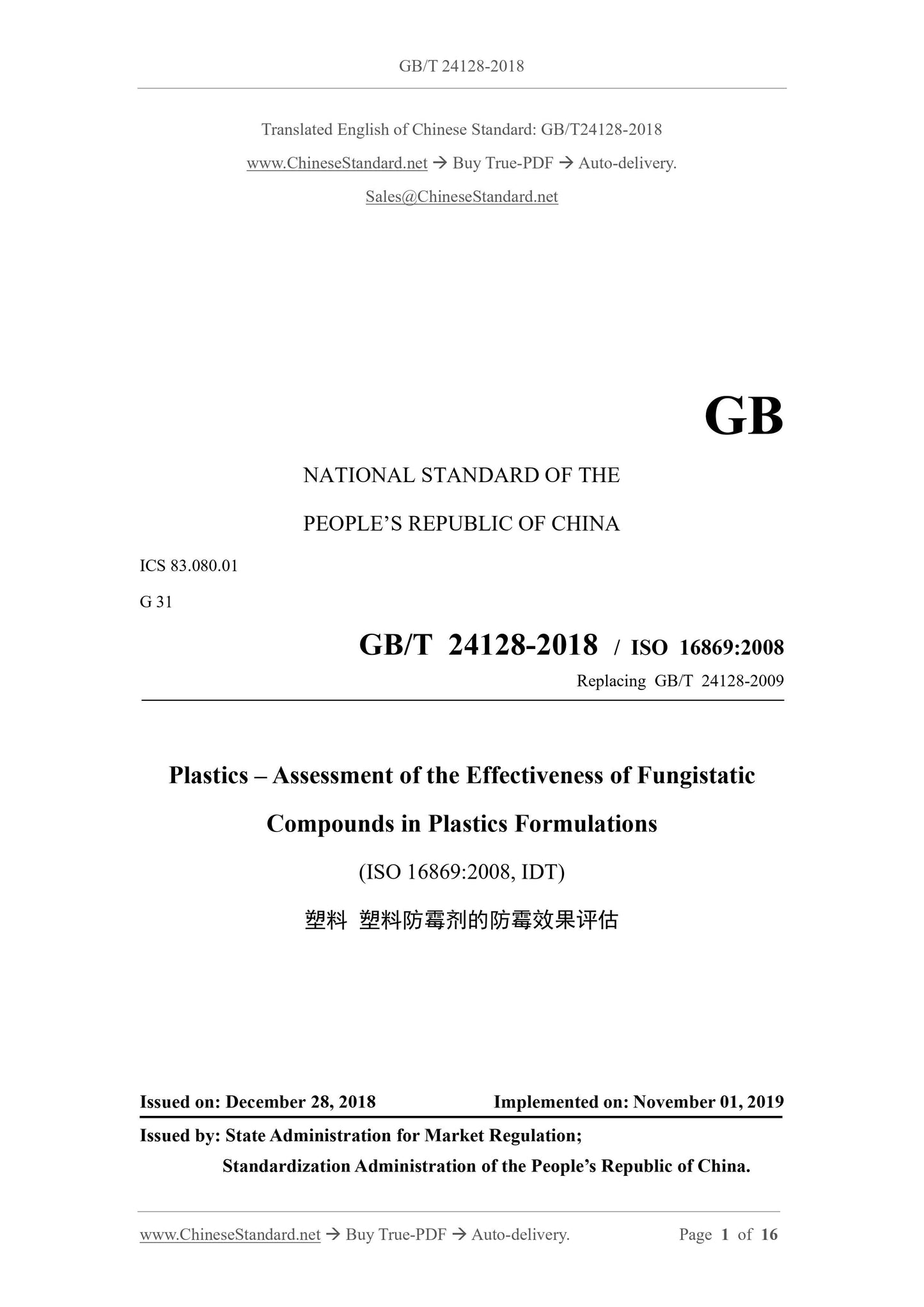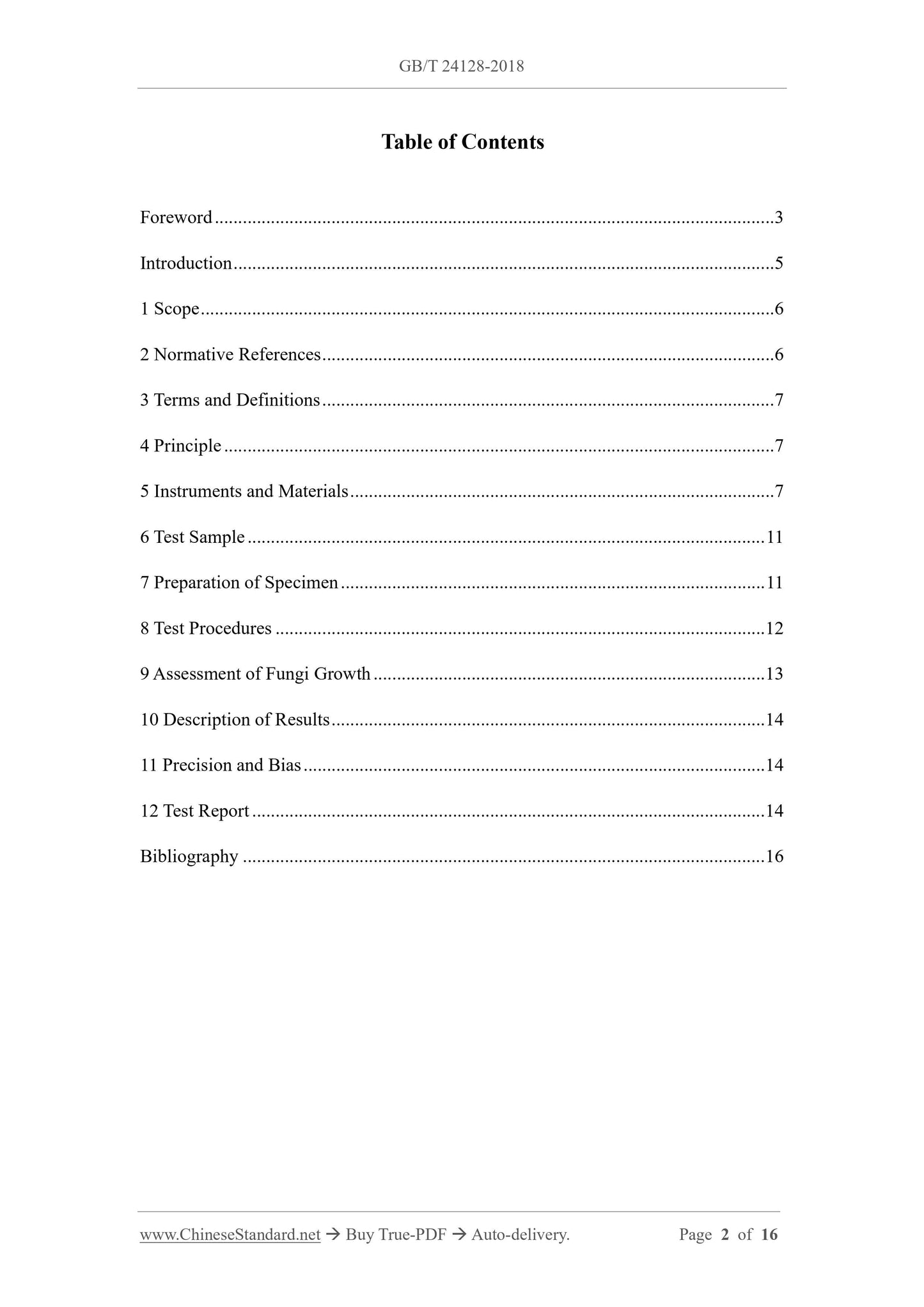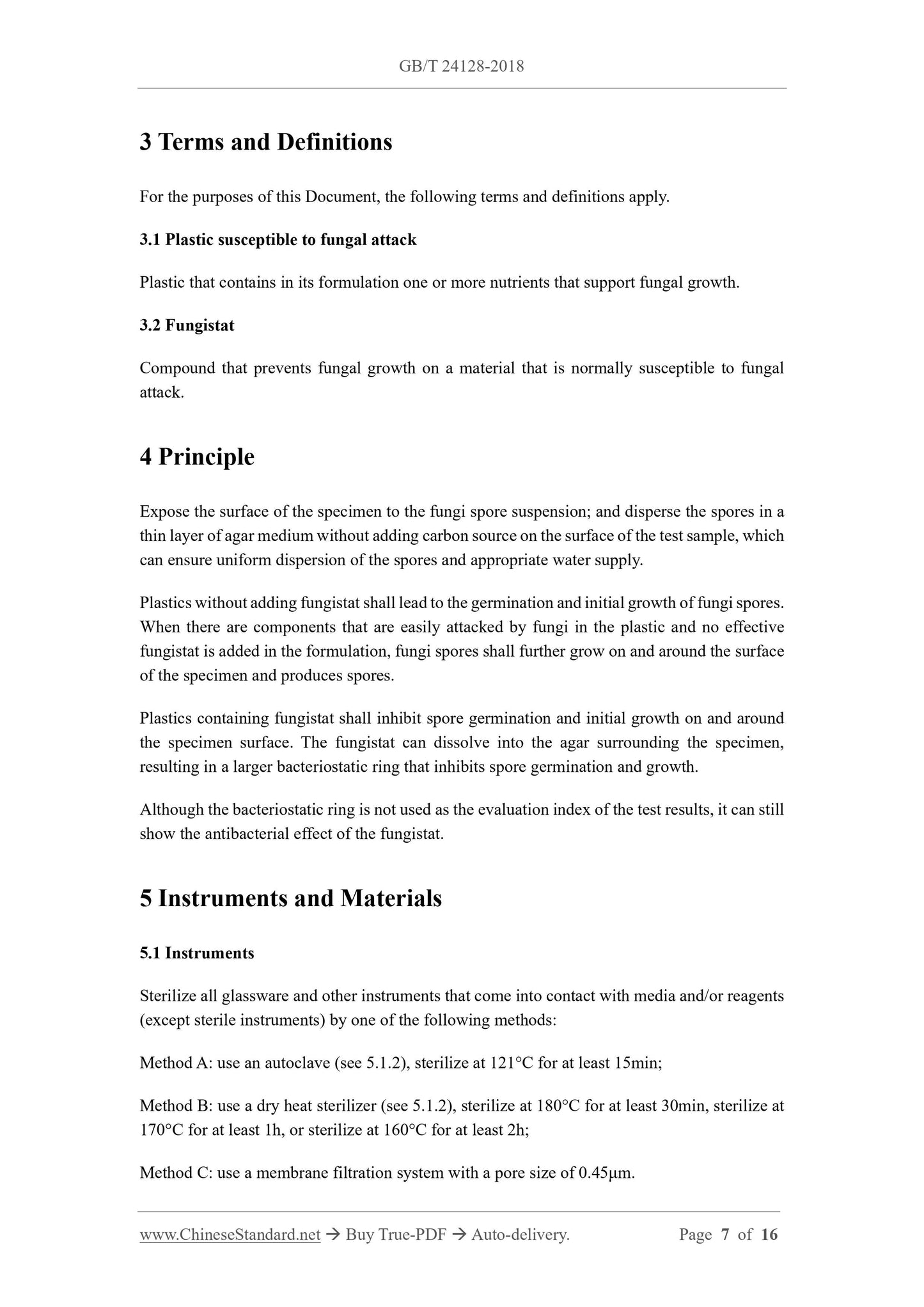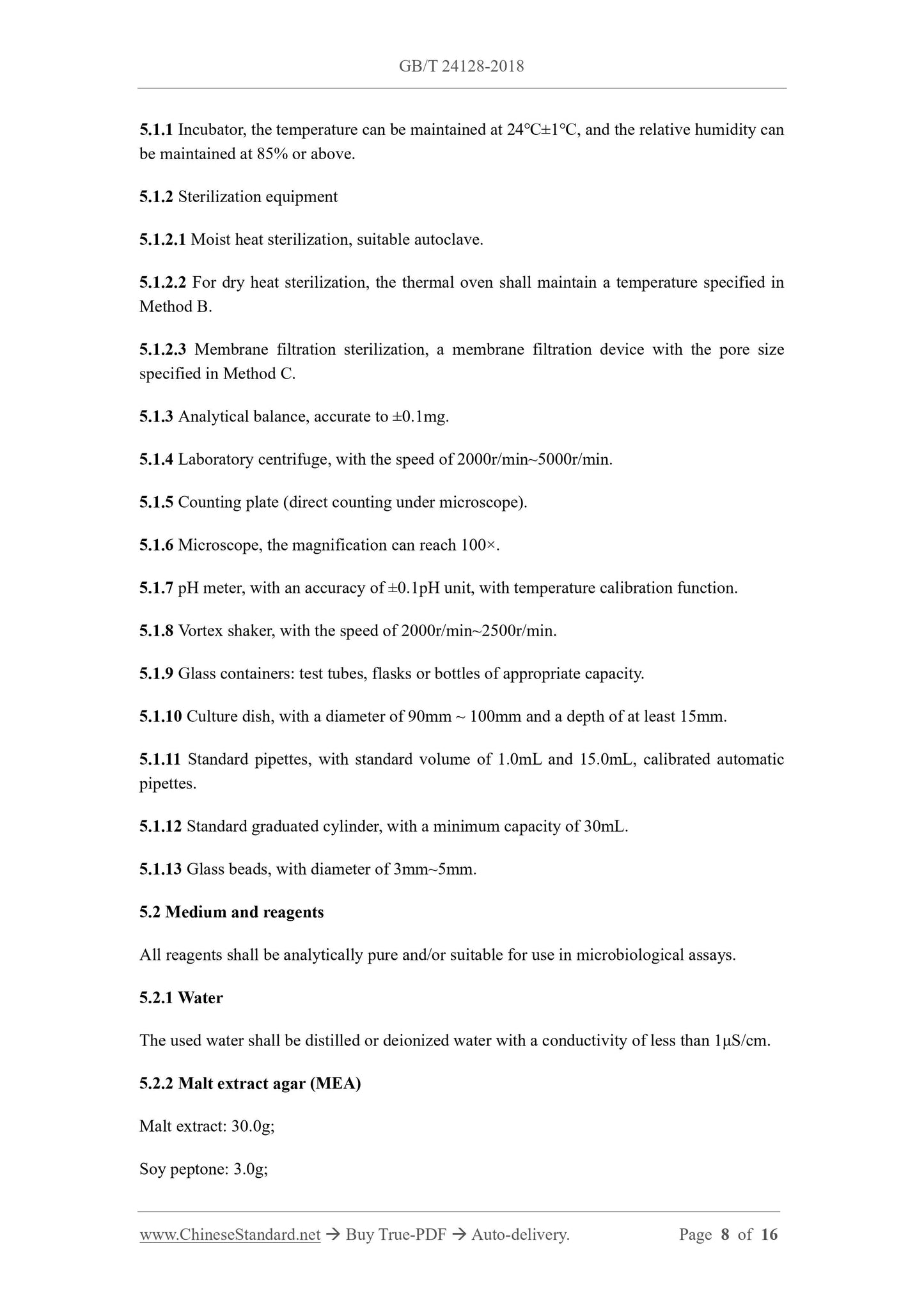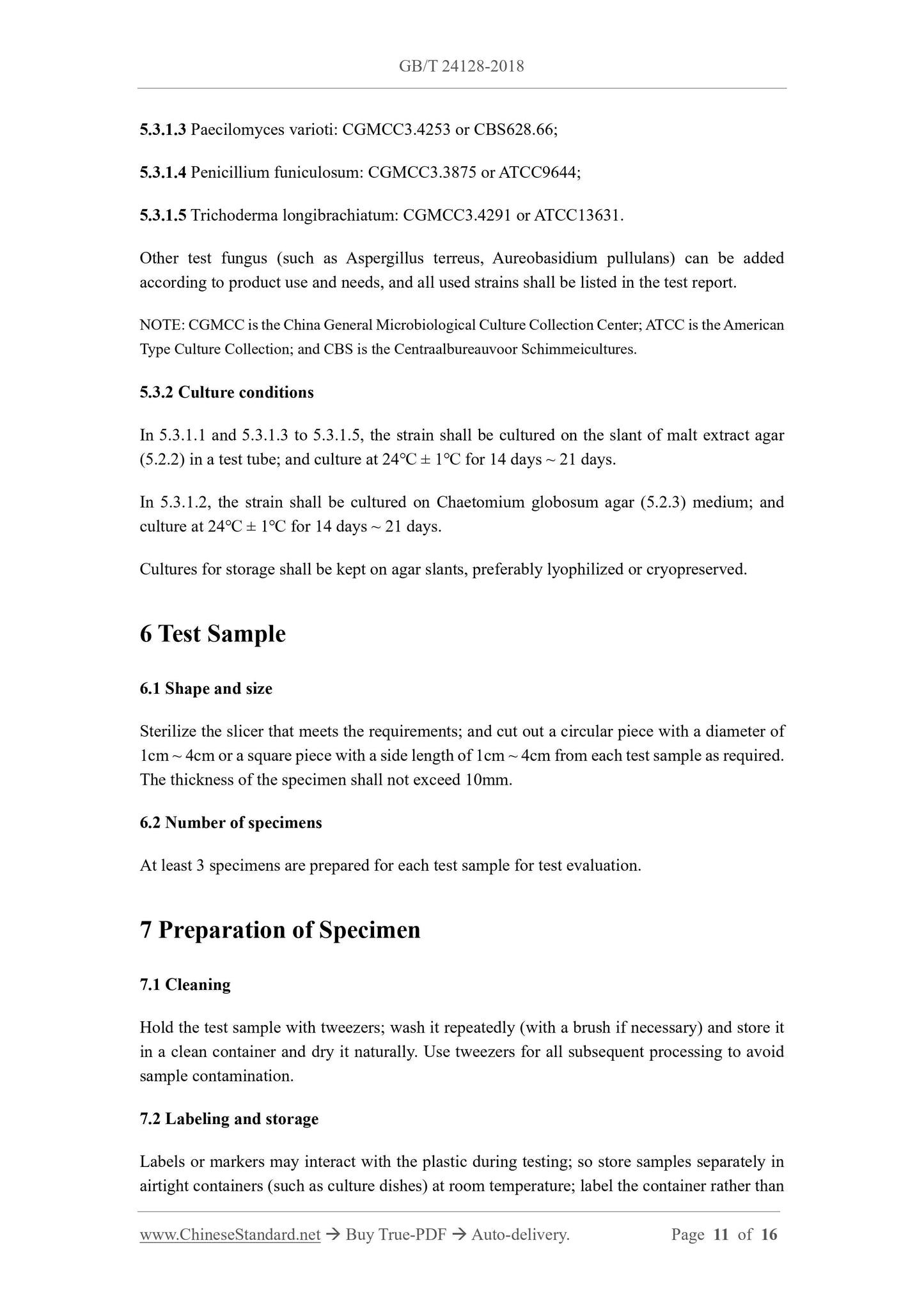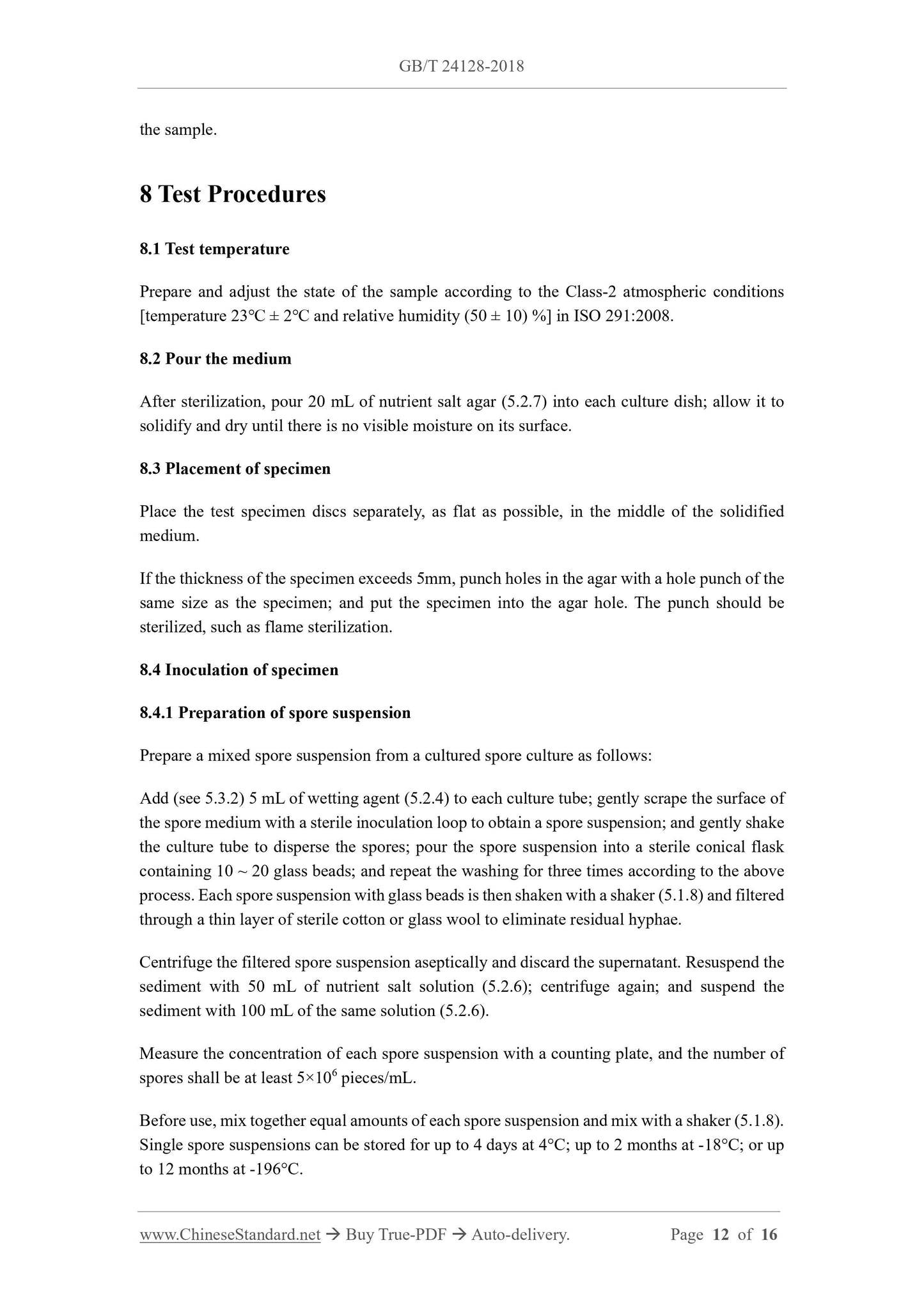1
/
of
7
PayPal, credit cards. Download editable-PDF & invoice In 1 second!
GB/T 24128-2018 English PDF (GBT24128-2018)
GB/T 24128-2018 English PDF (GBT24128-2018)
Regular price
$230.00 USD
Regular price
Sale price
$230.00 USD
Unit price
/
per
Shipping calculated at checkout.
Couldn't load pickup availability
Delivery: 3 seconds. Download true-PDF + Invoice.
Get QUOTATION in 1-minute: Click GB/T 24128-2018
Historical versions: GB/T 24128-2018
Preview True-PDF (Reload/Scroll if blank)
GB/T 24128-2018: Plastics -- Assessment of the effectiveness of fungistatic compounds in plastics formulations
GB/T 24128-2018
NATIONAL STANDARD OF THE
PEOPLE’S REPUBLIC OF CHINA
ICS 83.080.01
G 31
GB/T 24128-2018 / ISO 16869:2008
Replacing GB/T 24128-2009
Plastics – Assessment of the Effectiveness of Fungistatic
Compounds in Plastics Formulations
(ISO 16869:2008, IDT)
ISSUED ON: DECEMBER 28, 2018
IMPLEMENTED ON: NOVEMBER 01, 2019
Issued by: State Administration for Market Regulation;
Standardization Administration of the People’s Republic of China.
Table of Contents
Foreword ... 3
Introduction ... 5
1 Scope ... 6
2 Normative References ... 6
3 Terms and Definitions ... 7
4 Principle ... 7
5 Instruments and Materials ... 7
6 Test Sample ... 11
7 Preparation of Specimen ... 11
8 Test Procedures ... 12
9 Assessment of Fungi Growth ... 13
10 Description of Results ... 14
11 Precision and Bias ... 14
12 Test Report ... 14
Bibliography ... 16
Plastics – Assessment of the Effectiveness of Fungistatic
Compounds in Plastics Formulations
WARNING - Handling and operating potentially hazardous microorganisms requires
high technical competence and must comply with existing national laws and regulations.
These tests shall only be performed by personnel trained in microbiological techniques.
Relevant disinfection, sterilization and personal hygiene practices shall be strictly
implemented.
1 Scope
This Standard specifies a test method for determining the antifungal effectiveness of fungistat
used in plastic formulations to protect susceptible ingredients such as plasticizers and stabilizers.
This method can verify whether a certain plastic product can effectively prevent the erosion of
fungi.
The antifungal effect is evaluated by visual inspection.
This Standard applies to films or sheets made of plastics up to 10mm thick. In addition, porous
materials such as foamed plastics can also be tested by using this method when made into the
above forms.
The fungistat must have certain dissolution properties in the matrix.
Different from ISO 846, this Standard does not spray fungi spore suspension on the surface of
the sample, but covers a layer of spore-containing agar. This shall better disperse the spores and
provide the moisture necessary for spore germination on plastic surface that is normally
hydrophobic.
2 Normative References
The following documents are essential to the application of this document. For the dated
documents, only the versions with the dates indicated are applicable to this document; for the
undated documents, only the latest version (including all the amendments) is applicable to this
document.
ISO 291:2008 Plastics – Standard Atmospheres for Condition and Testing
3 Terms and Definitions
For the purposes of this Document, the following terms and definitions apply.
3.1 Plastic susceptible to fungal attack
Plastic that contains in its formulation one or more nutrients that support fungal growth.
3.2 Fungistat
Compound that prevents fungal growth on a material that is normally susceptible to fungal
attack.
4 Principle
Expose the surface of the specimen to the fungi spore suspension; and disperse the spores in a
thin layer of agar medium without adding carbon source on the surface of the test sample, which
can ensure uniform dispersion of the spores and appropriate water supply.
Plastics without adding fungistat shall lead to the germination and initial growth of fungi spores.
When there are components that are easily attacked by fungi in the plastic and no effective
fungistat is added in the formulation, fungi spores shall further grow on and around the surface
of the specimen and produces spores.
Plastics containing fungistat shall inhibit spore germination and initial growth on and around
the specimen surface. The fungistat can dissolve into the agar surrounding the specimen,
resulting in a larger bacteriostatic ring that inhibits spore germination and growth.
Although the bacteriostatic ring is not used as the evaluation index of the test results, it can still
show the antibacterial effect of the fungistat.
5 Instruments and Materials
5.1 Instruments
Sterilize all glassware and other instruments that come into contact with media and/or reagents
(except sterile instruments) by one of the following methods:
Method A: use an autoclave (see 5.1.2), sterilize at 121°C for at least 15min;
Method B: use a dry heat sterilizer (see 5.1.2), sterilize at 180°C for at least 30min, sterilize at
170°C for at least 1h, or sterilize at 160°C for at least 2h;
Method C: use a membrane filtration system with a pore size of 0.45μm.
5.1.1 Incubator, the temperature can be maintained at 24℃±1℃, and the relative humidity can
be maintained at 85% or above.
5.1.2 Sterilization equipment
5.1.2.1 Moist heat sterilization, suitable autoclave.
5.1.2.2 For dry heat sterilization, the thermal oven shall maintain a temperature specified in
Method B.
5.1.2.3 Membrane filtration sterilization, a membrane filtration device with the pore size
specified in Method C.
5.1.3 Analytical balance, accurate to ±0.1mg.
5.1.4 Laboratory centrifuge, with the speed of 2000r/min~5000r/min.
5.1.5 Counting plate (direct counting under microscope).
5.1.6 Microscope, the magnification can reach 100×.
5.1.7 pH meter, with an accuracy of ±0.1pH unit, with temperature calibration function.
5.1.8 Vortex shaker, with the speed of 2000r/min~2500r/min.
5.1.9 Glass containers: test tubes, flasks or bottles of appropriate capacity.
5.1.10 Culture dish, with a diameter of 90mm ~ 100mm and a depth of at least 15mm.
5.1.11 Standard pipettes, with standard volume of 1.0mL and 15.0mL, calibrated automatic
pipettes.
5.1.12 Standard graduated cylinder, with a minimum capacity of 30mL.
5.1.13 Glass beads, with diameter of 3mm~5mm.
5.2 Medium and reagents
All reagents shall be analytically pure and/or suitable for use in microbiological assays.
5.2.1 Water
The used water shall be distilled or deionized water with a conductivity of less than 1μS/cm.
5.2.2 Malt extract agar (MEA)
Malt extract: 30.0g;
Soy peptone: 3.0g;
5.3.1.3 Paecilomyces varioti: CGMCC3.4253 or CBS628.66;
5.3.1.4 Penicillium funiculosum: CGMCC3.3875 or ATCC9644;
5.3.1.5 Trichoderma longibrachiatum: CGMCC3.4291 or ATCC13631.
Other test fungus (such as Aspergillus terreus, Aureobasidium pullulans) can be added
according to product use and needs, and all used strains shall be listed in the test report.
NOTE: CGMCC is the China General Microbiological Culture Collection Center; ATCC is the American
Type Culture Collection; and CBS is the Centraalbureauvoor Schimmeicultures.
5.3.2 Culture conditions
In 5.3.1.1 and 5.3.1.3 to 5.3.1.5, the strain shall be cultured on the slant of malt extract agar
(5.2.2) in a test tube; and culture at 24℃ ± 1℃ for 14 days ~ 21 days.
In 5.3.1.2, the strain shall be cultured on Chaetomium globosum agar (5.2.3) medium; and
culture at 24℃ ± 1℃ for 14 days ~ 21 days.
Cultures for storage shall be kept on agar slants, preferably lyophilized or cryopreserved.
6 Test Sample
6.1 Shape and size
Sterilize the slicer that meets the requirements; and cut out a circular piece with a diameter of
1cm ~ 4cm or a square piece with a side length of 1cm ~ 4cm from each test sample as required.
The thickness of the specimen shall not exceed 10mm.
6.2 Number of specimens
At least 3 specimens are prepared for each test sample for test evaluation.
7 Preparation of Specimen
7.1 Cleaning
Hold the te...
Get QUOTATION in 1-minute: Click GB/T 24128-2018
Historical versions: GB/T 24128-2018
Preview True-PDF (Reload/Scroll if blank)
GB/T 24128-2018: Plastics -- Assessment of the effectiveness of fungistatic compounds in plastics formulations
GB/T 24128-2018
NATIONAL STANDARD OF THE
PEOPLE’S REPUBLIC OF CHINA
ICS 83.080.01
G 31
GB/T 24128-2018 / ISO 16869:2008
Replacing GB/T 24128-2009
Plastics – Assessment of the Effectiveness of Fungistatic
Compounds in Plastics Formulations
(ISO 16869:2008, IDT)
ISSUED ON: DECEMBER 28, 2018
IMPLEMENTED ON: NOVEMBER 01, 2019
Issued by: State Administration for Market Regulation;
Standardization Administration of the People’s Republic of China.
Table of Contents
Foreword ... 3
Introduction ... 5
1 Scope ... 6
2 Normative References ... 6
3 Terms and Definitions ... 7
4 Principle ... 7
5 Instruments and Materials ... 7
6 Test Sample ... 11
7 Preparation of Specimen ... 11
8 Test Procedures ... 12
9 Assessment of Fungi Growth ... 13
10 Description of Results ... 14
11 Precision and Bias ... 14
12 Test Report ... 14
Bibliography ... 16
Plastics – Assessment of the Effectiveness of Fungistatic
Compounds in Plastics Formulations
WARNING - Handling and operating potentially hazardous microorganisms requires
high technical competence and must comply with existing national laws and regulations.
These tests shall only be performed by personnel trained in microbiological techniques.
Relevant disinfection, sterilization and personal hygiene practices shall be strictly
implemented.
1 Scope
This Standard specifies a test method for determining the antifungal effectiveness of fungistat
used in plastic formulations to protect susceptible ingredients such as plasticizers and stabilizers.
This method can verify whether a certain plastic product can effectively prevent the erosion of
fungi.
The antifungal effect is evaluated by visual inspection.
This Standard applies to films or sheets made of plastics up to 10mm thick. In addition, porous
materials such as foamed plastics can also be tested by using this method when made into the
above forms.
The fungistat must have certain dissolution properties in the matrix.
Different from ISO 846, this Standard does not spray fungi spore suspension on the surface of
the sample, but covers a layer of spore-containing agar. This shall better disperse the spores and
provide the moisture necessary for spore germination on plastic surface that is normally
hydrophobic.
2 Normative References
The following documents are essential to the application of this document. For the dated
documents, only the versions with the dates indicated are applicable to this document; for the
undated documents, only the latest version (including all the amendments) is applicable to this
document.
ISO 291:2008 Plastics – Standard Atmospheres for Condition and Testing
3 Terms and Definitions
For the purposes of this Document, the following terms and definitions apply.
3.1 Plastic susceptible to fungal attack
Plastic that contains in its formulation one or more nutrients that support fungal growth.
3.2 Fungistat
Compound that prevents fungal growth on a material that is normally susceptible to fungal
attack.
4 Principle
Expose the surface of the specimen to the fungi spore suspension; and disperse the spores in a
thin layer of agar medium without adding carbon source on the surface of the test sample, which
can ensure uniform dispersion of the spores and appropriate water supply.
Plastics without adding fungistat shall lead to the germination and initial growth of fungi spores.
When there are components that are easily attacked by fungi in the plastic and no effective
fungistat is added in the formulation, fungi spores shall further grow on and around the surface
of the specimen and produces spores.
Plastics containing fungistat shall inhibit spore germination and initial growth on and around
the specimen surface. The fungistat can dissolve into the agar surrounding the specimen,
resulting in a larger bacteriostatic ring that inhibits spore germination and growth.
Although the bacteriostatic ring is not used as the evaluation index of the test results, it can still
show the antibacterial effect of the fungistat.
5 Instruments and Materials
5.1 Instruments
Sterilize all glassware and other instruments that come into contact with media and/or reagents
(except sterile instruments) by one of the following methods:
Method A: use an autoclave (see 5.1.2), sterilize at 121°C for at least 15min;
Method B: use a dry heat sterilizer (see 5.1.2), sterilize at 180°C for at least 30min, sterilize at
170°C for at least 1h, or sterilize at 160°C for at least 2h;
Method C: use a membrane filtration system with a pore size of 0.45μm.
5.1.1 Incubator, the temperature can be maintained at 24℃±1℃, and the relative humidity can
be maintained at 85% or above.
5.1.2 Sterilization equipment
5.1.2.1 Moist heat sterilization, suitable autoclave.
5.1.2.2 For dry heat sterilization, the thermal oven shall maintain a temperature specified in
Method B.
5.1.2.3 Membrane filtration sterilization, a membrane filtration device with the pore size
specified in Method C.
5.1.3 Analytical balance, accurate to ±0.1mg.
5.1.4 Laboratory centrifuge, with the speed of 2000r/min~5000r/min.
5.1.5 Counting plate (direct counting under microscope).
5.1.6 Microscope, the magnification can reach 100×.
5.1.7 pH meter, with an accuracy of ±0.1pH unit, with temperature calibration function.
5.1.8 Vortex shaker, with the speed of 2000r/min~2500r/min.
5.1.9 Glass containers: test tubes, flasks or bottles of appropriate capacity.
5.1.10 Culture dish, with a diameter of 90mm ~ 100mm and a depth of at least 15mm.
5.1.11 Standard pipettes, with standard volume of 1.0mL and 15.0mL, calibrated automatic
pipettes.
5.1.12 Standard graduated cylinder, with a minimum capacity of 30mL.
5.1.13 Glass beads, with diameter of 3mm~5mm.
5.2 Medium and reagents
All reagents shall be analytically pure and/or suitable for use in microbiological assays.
5.2.1 Water
The used water shall be distilled or deionized water with a conductivity of less than 1μS/cm.
5.2.2 Malt extract agar (MEA)
Malt extract: 30.0g;
Soy peptone: 3.0g;
5.3.1.3 Paecilomyces varioti: CGMCC3.4253 or CBS628.66;
5.3.1.4 Penicillium funiculosum: CGMCC3.3875 or ATCC9644;
5.3.1.5 Trichoderma longibrachiatum: CGMCC3.4291 or ATCC13631.
Other test fungus (such as Aspergillus terreus, Aureobasidium pullulans) can be added
according to product use and needs, and all used strains shall be listed in the test report.
NOTE: CGMCC is the China General Microbiological Culture Collection Center; ATCC is the American
Type Culture Collection; and CBS is the Centraalbureauvoor Schimmeicultures.
5.3.2 Culture conditions
In 5.3.1.1 and 5.3.1.3 to 5.3.1.5, the strain shall be cultured on the slant of malt extract agar
(5.2.2) in a test tube; and culture at 24℃ ± 1℃ for 14 days ~ 21 days.
In 5.3.1.2, the strain shall be cultured on Chaetomium globosum agar (5.2.3) medium; and
culture at 24℃ ± 1℃ for 14 days ~ 21 days.
Cultures for storage shall be kept on agar slants, preferably lyophilized or cryopreserved.
6 Test Sample
6.1 Shape and size
Sterilize the slicer that meets the requirements; and cut out a circular piece with a diameter of
1cm ~ 4cm or a square piece with a side length of 1cm ~ 4cm from each test sample as required.
The thickness of the specimen shall not exceed 10mm.
6.2 Number of specimens
At least 3 specimens are prepared for each test sample for test evaluation.
7 Preparation of Specimen
7.1 Cleaning
Hold the te...
Share
